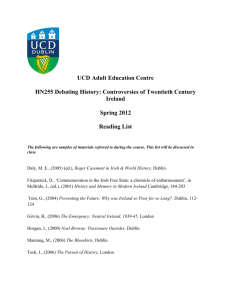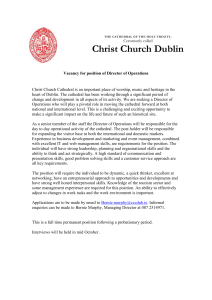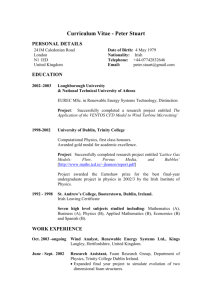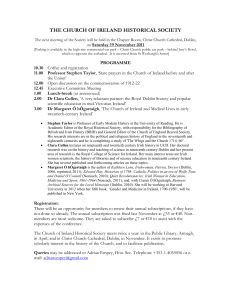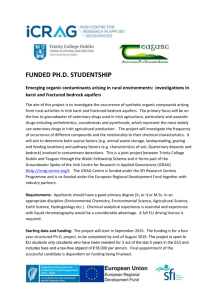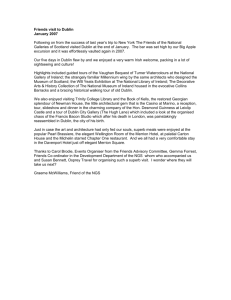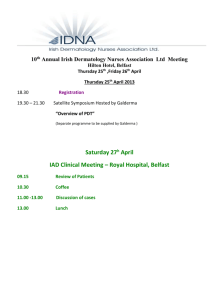dublin - Tailor Travels
advertisement
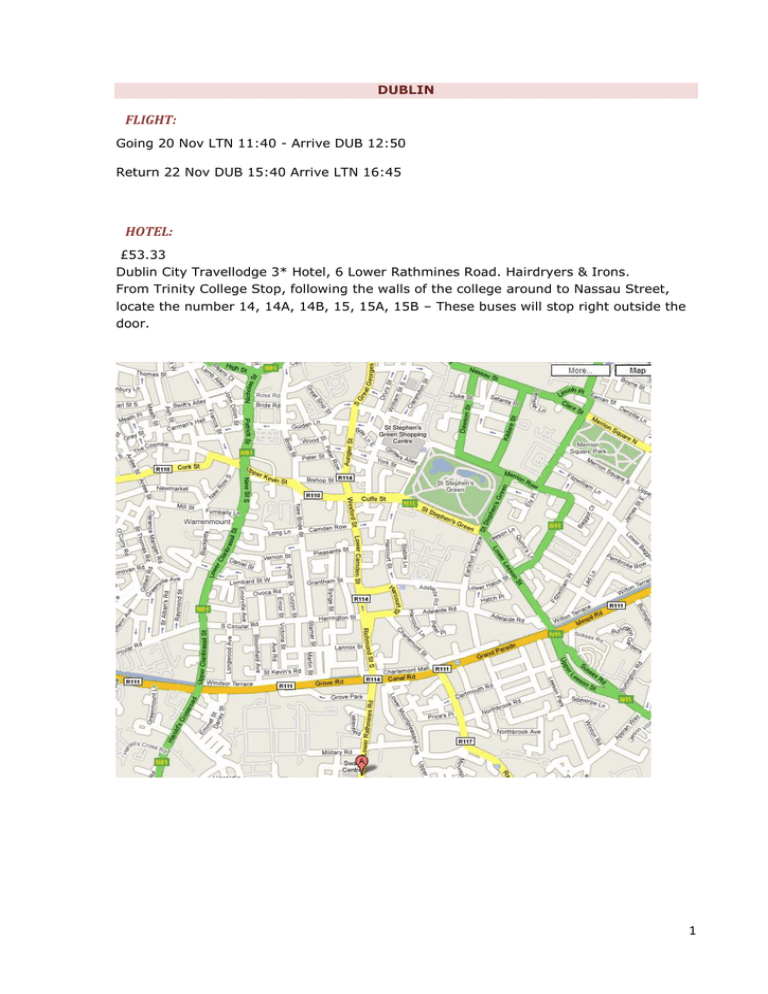
DUBLIN FLIGHT: Going 20 Nov LTN 11:40 - Arrive DUB 12:50 Return 22 Nov DUB 15:40 Arrive LTN 16:45 HOTEL: £53.33 Dublin City Travellodge 3* Hotel, 6 Lower Rathmines Road. Hairdryers & Irons. From Trinity College Stop, following the walls of the college around to Nassau Street, locate the number 14, 14A, 14B, 15, 15A, 15B – These buses will stop right outside the door. 1 Checklist: 1. Trinity College & Library 2. Dublin Castle 3. Guinness Storehouse 4. Christ Church Cathedral 5. St Patrick's Cathedral 6. Temple Bar 7. O'Connell Street 8. Bank of Ireland 9. The Custom House 10. Phoenix Park Route 16A: operates from Rathfarnham to the Airport. Service from the Airport is every 20 mins. All 16A buses from the Airport operate via the City Centre,routeing via O'Connell St., College Green and Georges Street en route to Rathfarnham. €1.55 Route 41.Route 41/41B/41C buses link Swords (1 mile North of the Aiport) with the City Centre. Every 15mins, not reiable. Departs Abbey Street in the City Centre and operates via. Gardiner St., Dorset St., Whitehall and Santry to the Airport. €1.55 adult Route 46A / 746 Route 46A buses hourly. The buses operate via the City Centre, Donnybrook and Stillorgan. €1.55 adult. Route 230 Route 230 buses maintain an erratic link between Dublin Airport and Portmarnock via Swords and Malahide, Every half hour €1.55 2 Trinity College and Library Founded in 1592 by Queen Elizabeth I on the grounds of an Augustinian priory that was a victim of the dissolution. Trinity College even today dominates the city landscape and the oldest buildings (the brick-built "Rubrics") date from 1700. Most of the impressive buildings were built during the renovation phase of 1759. Trinity College Library is home to more than an million books, most famous being the "Book of Kells". Open: Library: Mon-Sat: 9.30-17.00, Entry: Library: Adult: €7.50, Dublin Experience: Adult: €4.20 Dublin Castle If you are walking up Dame Street from Trinity College to Christ Church Cathedral, you will pass Dublin Castle on you left. And miss it. Not a castle in the classical sense. But the former seat of British power in Ireland should be on every agenda. 2 towers from the 13th century are part of Dublin's rare medieval heritage. State Apartments include a throne brought by William of Orange and other symbols of British rule. Mon-Fri 10-5pm, Sat, Sun 25pm, €5. 3 Guinness Storehouse With breathtaking views from the Gravity Bar and a complementary pint. €15 entry. Christ Church Cathedral Dublin's oldest building - the mother church of the dioceses of Dublin and Glendalough in the Church of Ireland. Viking Dublin's cathedral was built on this site c. 1030, and briefly became a cathedral priory under the Benedictines at the end of the 11th century. In 1162, the archbishop of Dublin, Laurence O'Toole (later canonised) introduced the canons regular of St Augustine to the cathedral where they remained until the Reformation. When Henry VIII broke from Rome, the Irish Church, however reluctantly, had to follow suit - and a majority of the bishops did. In Christ Church the last Augustinian prior, Robert Paynswick, became the first dean, and the chapter followed suit by changing from regular to secular. The present shape of the cathedral dates from the 1180s when a new programme of building was instigated under the first AngloNorman archbishop, John Comyn. An extended quire was added in the 14th century, and the collapse of the south wall of the nave in 1562 necessitated a temporary rebuilding, which lasted until the 1870s! George Edmund Street, one of the foremost Victorian architects of the time, undertook a complete restoration of Christ Church between 1871-8, at the expense of a Dublin whiskey distiller, Henry Roe, who gave 4 £230,000 (£23m today!) to save the cathedral. As part of this restoration, Street transformed the cathedral and added an elegant bridge across the road to a new hall built for the General Synod of the Church of Ireland, today used for an exhibition on medieval Dublin called Dvblinia. Every day 10am - 5pm admission: Requested donation. Daily: 09.45-17.00, €6 St Patrick's Cathedral Ireland's largest church & National Cathedral - this special status was conferred on a church were no bishop actually has his throne! Founded in 1191 by Archbishop Comyn the building was substantially renovated between 1844 and 1869 with moneys granted and raised by Sir Benjamin Lee Guinness. Visitors will thus find a neo-gothic cathedral with some older parts. Here you will also see the graves of Dean Swift (of "Gulliver" fame) and his beloved Stella. Mon-Sat 9am-6pm, €5 5 Temple Bar Dublin's "bohemian quarter" - Full of entertainment, art and culinary action. O'Connell Street & GPO Dublin's main traffic artery and the widest urban street in Europe. Dominated by statues inc the General Post Office (GPO), scene of the 1916 rebellion and faithfully rebuilt after being shelled by artillery and a warship. A bronze statue of Cuchullain remembers the fallen heroes. Bank of Ireland This centre of 20th century commerce. Built in 1729 to house the Irish Parliament, it became redundant when the British and Irish Parliaments were united in London, when the Irish Parliament voted itself out of existence. Magnificent chamber with woodwork in Irish oak, you can see the 18th century tapestries, and a sparkling Irish crystal chandalier of 1233 pieces. 6 The Custom House Designed by James Gandon. Built 1781-91. Designed to be looked at from all angles and is rich in structural detail. Of particular interest are the 14 keystone heads which represent the 13 Irish Rivers and the Atlantic Ocean. The original interior was destroyed by IRA in 1921. It currently houses the Dept of the Environment. Wed-Fri 10-12.30, €1. Phoenix Park One of the largest parks in the world and one of Dublin's main sights, the. Residences of the Irish President & Ambassador of the USA, from Ashtown Castle to the Garda Headquarters and from the herds of deer roaming free to the animals in Dublin Zoo. Do not miss the Phoenix Statue and the Papal Cross nearby. Martial history is emphasized by the massive Wellington Monument and the much-raided Magazine Fort on Thomas Hill. When King Charles II needed hunting grounds near Dublin, the Duke of Ormonde landscaped the area north of tge Liffey, stocking it with deer to prevent these from escaping park is surrounded by a wall. 5x the size of London's Hyde Park, double the size of New York's Central Park, 707 hectares in all. 7
